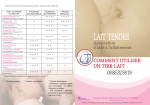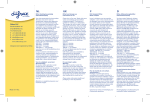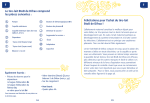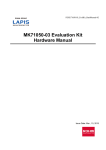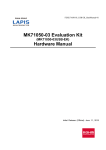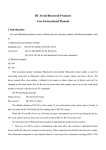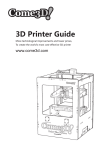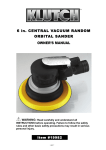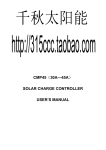Download Selecting a Breast Pump
Transcript
Selecting a Breast Pump There is a great variety of breast pumps to choose from. It is hard to make a decision about which one will be effective and comfortable for you! Basic Parts of a Breast Pump The basic parts of a breast pump will vary from manufacturer to manufacturer. But these are typical: Tubing attaches to a Connector motor on an electric with valve breast pump. In the case of a manually operated pump, a handle would be located here. Flange goes Bottle over the breast Single and Bilateral Breast Pumps Breast pumps can remove milk from one breast at a time or both breasts simultaneously. Of course, bilateral pumping cuts the time in half. In addition, it stimulates the hormones of lactation better. Pumps fall into four basic categories: • Hospital grade pumps – Generally rental pumps, used while establishing a milk supply if your infant is premature or ill • Personal use pumps – Generally used by employed mothers at work • Battery or small electric pumps – Generally used by employed mothers or for occasional use • Manually operated breast pumps – Best used for occasional use Selection Criteria: • • • • • • Purpose Age and health of infant Comfort Availability Cost Ease of use • Adjustable suction and frequency • Adjustable breast flange • Ease of cleaning • Universal collection container • Durability • Versatile power source • Portability • Safety Purpose: Is your infant premature, ill or do you need to be separated from your infant for any reason? Using a hospital grade pump would be best. It is the only type that is designed to start your milk supply when you are not breastfeeding yet. If a hospital grade pump is not available, then a bilateral electric personal use pump would be your second choice. If you will be working and away from your baby for eight or more hours, select a personal use pump. If you will be using your pump occasionally, a battery, small electric or manually operated pump will be fine. Age and health of infant: If your infant is a newborn and your milk supply is not well established, choose a hospital grade or personal use pump. Comfort: Select a pump that has adjustable suction levels and flanges so you can adjust them to your comfort. Availability: Breast pumps may be available at your hospital, from a lactation consultant, at a local baby store or on-‐line (see websites below). For information about renting a breast pump in China, contact: Shanghai: www.lunabellelactation.com Beijing: [email protected] Taiyuan/Yangqu: www.yunfuxuexiao.net China: www.taobao.com Cost: Pumps range in price from over 100 rmb to 3000+ rmb. Purchase or rent the best pump you can afford, it will make a difference! Ease of use: The pump should come with clear instructions and be easy to figure out. If it is very complicated, you won’t end up using it. Adjustable suction and cycle frequency: You want your pump to mimic the typical suction patterns of a baby at the breast. Therefore the suction range should be adjustable up to about 240 mmHg and cycle about 48-‐50 times per minute. Breast pump packages are not labeled with this information at this time. Durability: What kind of warranty does the pump have? Is it likely that you can use it for this baby and another baby or two? Adjustable breast flange: Many pumps come with a standard size flange that fits most women. However, if you have very small or very large nipples, you will need a flange that fits you. You can tell the flange fits you if it completely supports the areola and does not pull any areola into the flange indicating it would be too large. You can tell if the flange is too tight if the nipple is tight in the nipple tunnel, hurts or does not empty the breast completely. Ease of cleaning: Check the small parts. Is it likely that small, but essential parts could slip down the sink and be lost? Is the pump easy to reassemble? See our handout “Cleaning Your Breast Pump” to read instructions on cleaning the pump. Universal collection container: Most pumps will accept any standard baby bottle and it is convenient to be able to mix and match with any bottles you have handy. Others require their own particular size. Versatile power source: It is useful that an electric pump can be plugged in, but also could be operated on batteries at other times. In the case of a power outage, you should be able to operate it manually. Portability: Where will you use the pump? Will there be times you will need to quickly put it in your purse or wear it as a backpack? Or will you always be sitting in a designated pumping room? Safety: If it is operated by electricity, the pump should be rated by the Underwriters Laboratory as safe. Check to assure it will automatically cut off at suction levels above 240 mmHg, which could damage the breast tissue. Buying a Second Hand Personal Use Pump A good quality bilateral personal use pump can be expensive to buy. Renting one (see information above) or buying a second hand pump is another option. When buying a second hand pump there are some things that need to be taken into consideration: 1. Choose a pump with a closed system. When using a pump with an open motor, milk can get into the pump, possibly leaving behind bacteria. Below a list of pumps with an open and a closed system. Pumps with Open System Breastflow electric pump Difrax BtoB pump Medela Mini Electric Medela Mini Electric Plus Medela Pump in Style Advanced Medela Swing 2. 3. 4. 5. Pumps with Closed System Ameda Lactaline Personal Ardo Calypso Ardo Calypso To Go Ardo Calypso Double Plus Medela Freestyle Philips Avent Isis IQ Duo Buy a new kit. The parts of a personal use pump with a closed system that do get into contact with milk, should be cleaned after each pumping session (see our handout “Cleaning Your Breast Pump”). When buying a second hand pump, it is best to replace these parts and buy a new kit for that particular pump. How long and often has the pump been used? The more intense a pump has been used, the greater the chance that the motor breaks down. Replacing a motor is almost as expensive as buying a new pump. No warranty. Be aware that you might not have a warranty on a second hand pump. Is it complete? Make sure the breast pump is complete with manual, tubes, connector with valve and bottles. Selected Major Pump Manufacturers Medela: www.medela.com/CN/zh/breastfeeding.html Ameda: www.ameda.com.cn Ardo: www.ardo.com.cn Resources FDA Breast Pump Website – Basic information on breast pumps Breast Pumps Direct – User review of various breast pumps Breast Pump Comparisons – User reviews of various breast pumps Are Used Breast Pumps a Good Option? -‐ Issues to Consider. Please be aware that the information provided is intended solely for general educational and informational purposes only. It is neither intended nor implied to be a substitute for professional medical advice. Always seek the advice of your physician for any questions you may have regarding your medical condition. Never disregard professional medical advice or delay in seeking it because of something you have received in this program. Handout provided for you by www.yunfuxuexiao.net. Source: Lactation Education Resources



